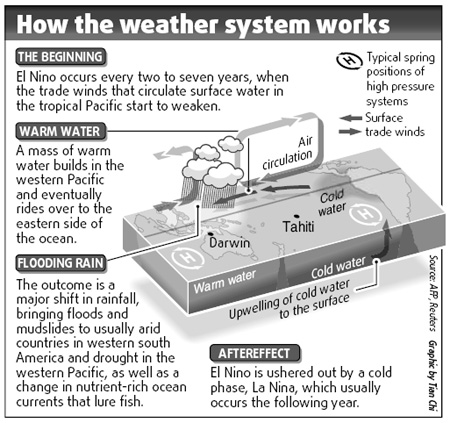Climate patterns can predict El Nino's arrival
Tracking Indian Ocean climate patterns could improve early-warning systems for the El Nino phenomenon, helping save lives and billions of dollars lost each year to the severe weather it causes.
In a paper published in Nature Geoscience, researchers in Japan and France said their new forecast model could predict an El Nino 14 months ahead of time, several months earlier than with current methods.
"It is important because ... this helps to improve El Nino forecasts. It can save a lot of money for agriculture," said lead researcher Takeshi Izumo at the Research Institute for Global Change in Yokohama, Japan.
The El Nino phenomenon is a climate pattern that occurs periodically over the Pacific Ocean and is well known for the havoc it wreaks such as floods, droughts and other forms of severe weather.
The weather anomaly whacks countries around the Pacific and affects southern Africa and even Europe.
At present, scientists are unable to give little more than a few months' notice that an El Nino is in the offing, which is often too late for farmers, fishermen and others to prepare for weather disruption.
Developing countries heavily dependent on agriculture and fishing are most badly affected, though the 1997-1998 El Nino cost the US an estimated $25 billion, according to the US National Oceanic and Atmospheric Administration.
Izumo and his colleagues found that the Indian Ocean Dipole (IOD), the equivalent of an El Nino in the Indian Ocean, had a role in causing the phenomenon.
"IOD strongly influences the triggering of El Nino (the following year). In this study, we did a simple forecast model, we included the IOD index and we can have a very good forecast for the El Nino in the next year," Izumo said.
"Because of the overwhelming consequences of El Nino on global weather, ecosystems, and its strong socioeconomic and ecological consequences, El Nino forecasting is important for disaster prevention and impact management, and helps to reduce El Nino-related losses," Izumo said.
During the 1997 El Nino, one of the strongest recorded, Indonesia suffered a large number of fires, partly caused by drought, he said. Better forecasting could have helped reduce the number of fires through prevention measures.
 |
|
[China Daily] |
 0
0 







Go to Forum >>0 Comments